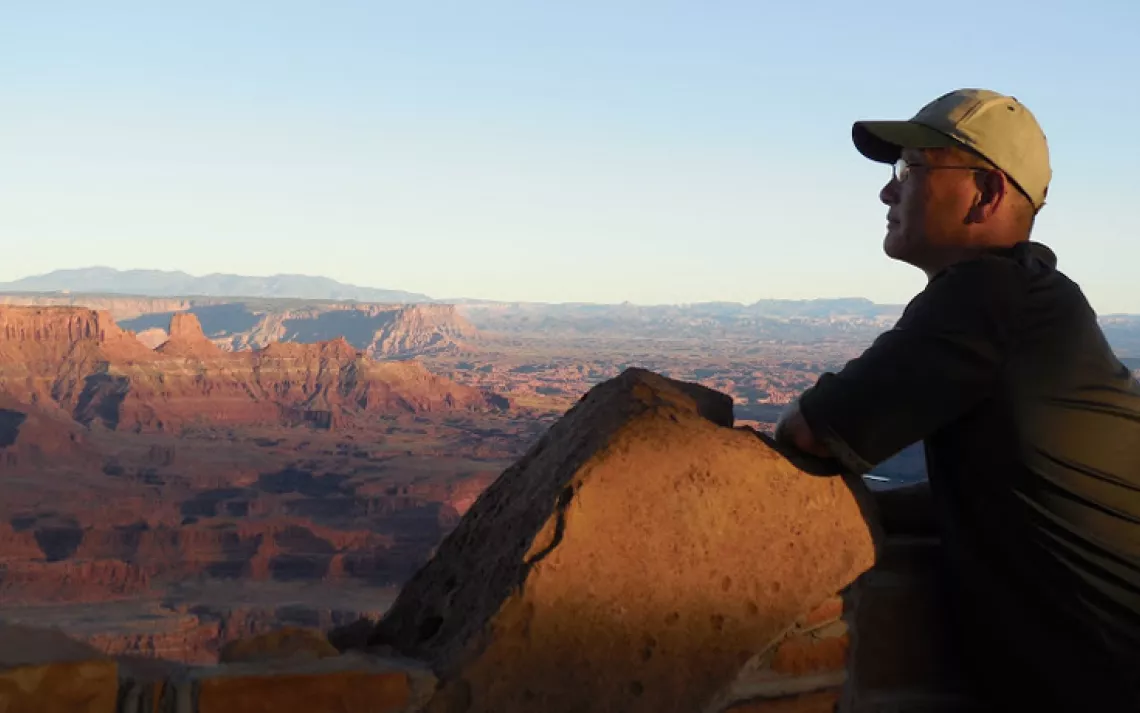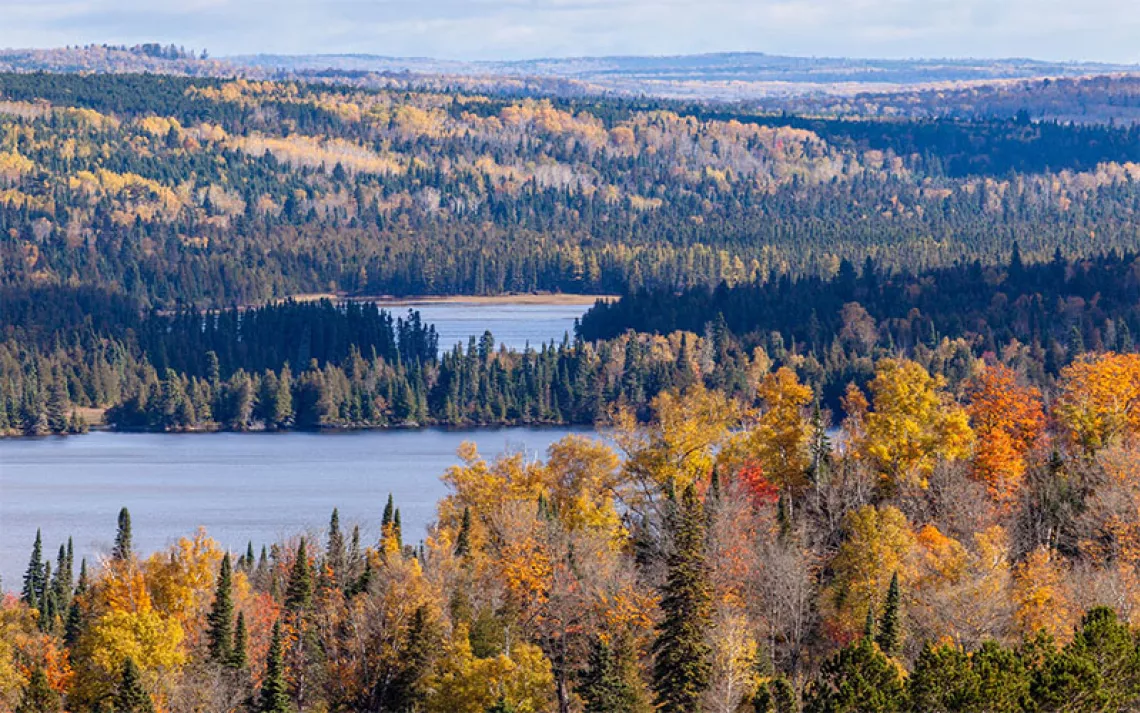Wild at Heart
The Club rebrands--and rethinks--the struggle that started it all

Dan Chu, head of the Sierra Club's Our Wild America campaign, at Canyonlands National Park | Photo by Marion Klaus
Two years before John Muir founded the Sierra Club, his seminal essay "The Treasures of the Yosemite" described the valley and its surroundings in exhaustive, loving detail. It also conspicuously raised the specter of loss. "In Yosemite, even under the protection of the Government," Muir wrote early in the piece, "all that is perishable is vanishing apace."
Which illustrates what most of you already know: that the Sierra Club was created, first and foremost, to protect American wilderness. Of course, Muir wrote those words more than 120 years ago, at a time when coal-ash mudslides, flammable tap water, and human-fueled global warming were part of an unfathomable future. The Club has adjusted to that future by expanding and redefining its mission, and Muir's original agenda has grown to include such campaigns as Beyond Coal, Beyond Oil, and Beyond Natural Gas.
But the Sierra Club remains dedicated to land protection, and recently that core effort got a new leader, Dan Chu; a new name, Our Wild America; and a new set of initiatives. As part of its tribute to the 50th anniversary of the Wilderness Act, Sierra pulled Chu aside to ask him about wilderness protection in an overheating world.
The Club recently renamed its land-protection campaign Our Wild America. Why?
We want to ensure that the Club's land-protection work, which really is our legacy, reflects the nation's changing demographics. California, for instance, is at the point now where whites are becoming a minority, and Hispanic populations are growing in many states. The millennial generation is an increasingly important political bloc. The good news is that those groups' core values are consistent with the mission of the Sierra Club. They care deeply about protecting shared public spaces, and about clean water and clean air. So the Club is committing to a concerted effort to engage these and other diverse constituents.
How does the name change reflect that effort?
The campaign includes the word "our" to emphasize the collective nature of the effort--that our land, water, and wildlife are assets owned and stewarded by all Americans, for all of us to enjoy. It also suggests that we have a shared responsibility to protect those lands for current and future generations. The word "wild" reminds people that we must have healthy and vibrant places where wildlife and flora can thrive. And "America" not only reiterates that sense of a collective mission but also suggests that protecting green space and public lands is a patriotic pursuit. America was one of the first countries to actually set aside land for all of its citizens to enjoy--not just those at the top of the social ladder.
But it's more than just a renaming, right? The former name for the Club's land-protection campaign, Resilient Habitats, seems like it was aimed at enabling wild areas and animals to survive climate change.
The Resilient Habitats campaign focused on improving protections to large core areas and then creating connections between those areas so that wildlife would have corridors to move through--all in response to threats from a changing climate. So it was a climate-adaptation strategy. And it was fairly science-heavy.
What are the new campaign's goals?
We have four main initiatives. The first is securing permanent protections for wildlands and marine areas, which means getting lines drawn on a map that protect those places forever from development, as when the president creates a new national monument. The second is keeping fossil fuels on public lands from being extracted and released into the atmosphere. The third piece, called Nearby Nature, is fairly new and different from Resilient Habitats in that we're reaching out to previously underserved communities to help them enjoy and ultimately protect green spaces close to their communities. Finally, we continue to advance the goals of the Resilient Habitats campaign, to protect and connect important forested habitats for wildlife.
Given the urgency of the climate change fight, do you sometimes feel that the Club's land-protection efforts have taken a backseat in recent years?
I haven't had that sense. A large percentage of our members see wilderness and wildlife protection as a top priority. I feel good about that. The Beyond Coal and Beyond Oil campaigns are working on reducing demand for fossil fuels, while Our Wild America is trying to keep those fuels in the ground. It's synergistic: When we reduce demand, there's less pressure to frack for oil or mine for coal. At the same time, we're building a constituency of land-protection advocates who aren't necessarily motivated by climate change. They're more worried about having their water poisoned or their wildlands destroyed.
Do you ever hear from members who ask, "Hey, whatever happened to the wilderness-protection mission of the Sierra Club? All I'm hearing about nowadays are coal and fracking."
No. People tend to call me to talk about specific wildland issues. I get letters on wolves and other species--[asking] what are we doing about it? One of the reasons I came to the Sierra Club is that I wanted to be at a place that's addressing the core drivers behind threats to America's wilderness and wildlife, and one of those is the country's ongoing addiction to fossil fuels. Beyond the climate impact, drilling for oil results in things like the BP oil tragedy or the Exxon Valdez spill, while fracking has poisoned water in places like Pennsylvania and West Virginia. The Our Wild America campaign is very well positioned right now. It's where people go if they want to protect rivers from mining or forests from logging or parks from fracking.
There's an interesting debate about wilderness--the idea that we should protect areas not just from development but also from people in general, because there's a need to preserve it for its own sake.
The Wilderness Act is very specific about what can and can't happen in a designated wilderness area. Basically, anything that involves wheels is banned, and that has created conflicts in some cases with groups that would otherwise be our allies. For instance, in the effort to expand the Alpine Lakes Wilderness Area in Washington, we realized that the new boundaries included a trail that's popular with mountain bikers. So we helped to ensure that the boundaries didn't include that trail, and in return, the mountain bikers came in and supported the campaign to expand that wilderness area. It helps sometimes to create buffers around wilderness areas that allow for broader recreational opportunities.
Why have there been so few wilderness area designations in recent years?
Many Western Republicans don't want the federal government to control more land than it already does, and they want to limit oversight on the land it currently controls.
Which explains why you've been focusing on national monuments, which the president can designate without congressional approval.
Yes. President Obama has already designated 11 national monuments, the largest two being the Organ Mountains-Desert Peaks [about 500,000 acres] and the Rio Grande del Norte [about 240,000], both in New Mexico. Additionally, the two other big national monuments that we'd like to see him designate are buffers around Grand Canyon and Canyonlands National Parks. We're also pushing for national monuments in California, Idaho, and Colorado. Together, these would add more than 4 million acres of new national monuments.
The campaign's mission statement mentions threats to bedrock environmental laws. What are the threats, and how afraid are you?
The fight that comes up again and again is the attempt to reduce the president's power under the Antiquities Act, and to mandate congressional approval of any proposed national monuments. There are also always attempts in Congress to weaken the National Environmental Policy Act, the Clean Water Act, and the Endangered Species Act.
How much of a departure from Sierra Club tradition is Our Wild America's Nearby Nature program?
Actually, it isn't that different from what the Club's been doing for over 100 years--getting people from diverse walks of life out there to experience, enjoy, and connect with each other, and then ultimately get inspired to protect places that are under threat. What's new is that we're focusing on a different constituency than we have in the past. We want to persuade people who've never really thought of themselves as environmentalists that protecting green space is good not only for the environment but also for their community's health and welfare.
Promoting urban green spaces is a pretty far cry from protecting Yosemite.
That's right. Part of it is the Club's recognition that connecting people with nature, whether it be Yosemite or a city park, is also an issue of equity and accessibility. Just because you can't get to a huge remote place like the Arctic National Wildlife Refuge, it's still a place that you should care about. And a way you can care about it is by engaging with a green space close to home. Getting outdoors is also just good for the community. Having healthy wild places is critical to having healthy people.
 The Magazine of The Sierra Club
The Magazine of The Sierra Club






